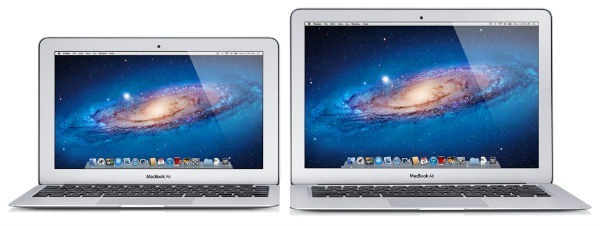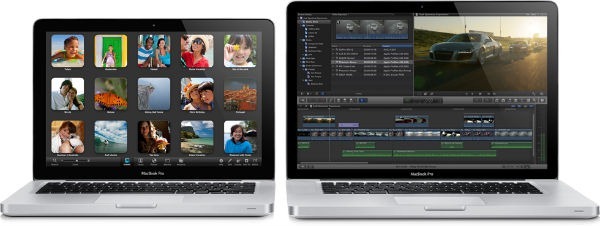Apple kicked off its Worldwide Developers Conference by announcing a redesigned MacBook Pro that’s nearly as thin as a MacBook Air–with a Retina display to boot.
The company also announced iOS 6–the latest version of its iPhone, iPod Touch and iPad software–and some more features for Mac OS X Mountain Lion.
MacBook Pro with Retina Display

The new MacBook Pro is a 15-inch laptop that measures 0.71 inches thick and weighs 4.46 pounds. The Air is still a bit thinner, due to its tapered design, but the new MacBook Pro is 25 percent thinner than previous models–thanks in part to its lack of a DVD slot.
The redesigned MacBook Pro also includes a “Retina” display–Apple’s term for when the human eye can’t distinguish individual pixels at a normal viewing distance–with a resolution of 2880-by-1800. Apple and some third-party developers have already updated their Mac OS X apps for the Retina display. Other apps will be pixel-doubled until developers update them.
(PHOTOS: Apple’s 2012 Worldwide Developers Conference Keynote)
Other specs for the new MacBook Pro include up to a 2.7 GHz Core i7 processor, up to 16 GB of 1600 MHz RAM, Nvidia GeForce GT 650M Kepler graphics (good enough to play Diablo III, Apple claims), up to 768 GB of flash storage and up to 7 hours of battery life, or 30 days on standby. The new design has ports for SD, HDMI, USB 3.0 on either side, two Thunderbolt ports, a headphone jack and a slimmer MagSafe charging port. The laptop also has an HD camera for FaceTime and dual microphones.
The starting price for the MacBook Pro is $2,199, and includes a 2.3 GHz quad-core i7 processor, 8 GB of RAM and 256 GB of flash storage.
MacBook Air and MacBook Pro
For Mac fans without such deep pockets, the old MacBook Pro and MacBook Air aren’t going away just yet. Apple announced some spec boosts for its other laptops, which will retain the same design as previous models.

Here are the basics on the new MacBook Air:
- Intel Ivy Bridge processors with speeds up to 2 GHz
- Up to 8 GB of RAM
- 60 percent faster graphics
- Up to 512 GB of storage
- USB 3.0 on all ports
- 720p FaceTime camera
The 11-inch and 13-inch models will start at $999 and $1,199, respectively–the same prices as before–but high-end versions will be $100 cheaper at $1,099 for the 11-inch Air and $1,499 for the 13-inch Air.

And the MacBook Pro:
- Ivy Bridge, with up to 2.7 GHz quad-core i7 processors available on the 15-inch model
- 8 GB of RAM
- 60 percent faster graphics
- USB 3.0 ports
The 13-inch model starts at $1,199, and the 15-inch model starts at $1,799–same prices as before. Apple did not announce any updates for the 17-inch MacBook Pro.
Of course, seeing as WWDC is a developers conference, much of the day’s news focused on software that app makers can take advantage of, and Apple made some big announcements for both iOS 6 and OS X.
Mountain Lion

My colleague Harry McCracken has already written extensively about OS X Mountain Lion, but Apple announced a handful of new features for the desktop and laptop operating system:
- A unified search and URL bar in Safari, and “iCloud Tabs,” which syncs open tabs across devices
- A faster scrolling engine for Safari, with the ability to pinch-zoom out into large thumbnail views of open tabs
- “Power Nap,” which allows Macs to fetch e-mail, calendar updates and photos, and to back up to a Time Capsule or download updates while the computer is asleep
- Airplay mirroring from a Mac to an Apple TV box
- Game Center support, with cross-platform play between OS X and iOS
Mountain Lion will launch through the Mac App Store in July for $20. Any Mac running Snow Leopard or Lion will be able to upgrade at that price.
iOS 6

The next version of Apple’s iOS software is a major update with some long-requested features, as well as a few surprises:
- Apple’s rumored homegrown Maps service arrives with iOS6, and at long last, includes turn-by-turn navigation. Maps allows users to tap on a destination, get automatic rerouting around traffic and Siri integration. Apple says it supports 100 million local listings.
- Siri will let users launch apps by voice. Some vehicles will be able to launch Siri through a steering wheel button, with support coming from GM, BMW, Honda, Jaguar and others. Siri is also coming to the new iPad.
- Facebook integration will allow users to post to the network from various apps, from the Notification center, and from Siri. Users will able to see contact info and birthdays for their Facebook friends and “Like” content in iTunes.
- For incoming calls, users will be able to reply with a text message or get a reminder to call later.
- A “Do Not Disturb” mode will prevent push notifications from making noise or turning on the screen. It can also block phone calls or only allow calls from select users.
- FaceTime is coming to cellular networks. Users will also be able to answer incoming phone calls as FaceTime chats on an iPad or Mac.
- Safari can show notifications when users visit a website that has a native app in the App Store. If the app is installed, users can visit the same location within the app. (Think of local listings pages in Yelp, for example.)
- Safari will support photo uploads to websites, which should be useful for bloggers.
- The Mail app supports photo and video attachments, pull-to-refresh and opening of password-protected Office files. A “VIPs” section allows users to get notifications from select users, and see their e-mails in a special inbox.
- Passbook is a built-in app for discount cards, gift cards, movie tickets and boarding passes. It’s location aware, too: Arrive at your airport gate and your boarding pass pops up in the lock screen, arrive at Starbucks and your Starbucks card pops up, for example.
- iOS 6 includes better guided access for blind people and children with autism.
Developers will be able to use a beta version of iOS 6 starting today. It ships this fall for the iPhone 4, iPhone 4S, iPad 2, new iPad and fourth-generation iPod Touch.
MORE: A Brief History of Apple’s WWDC Keynotes, 1997-Present

